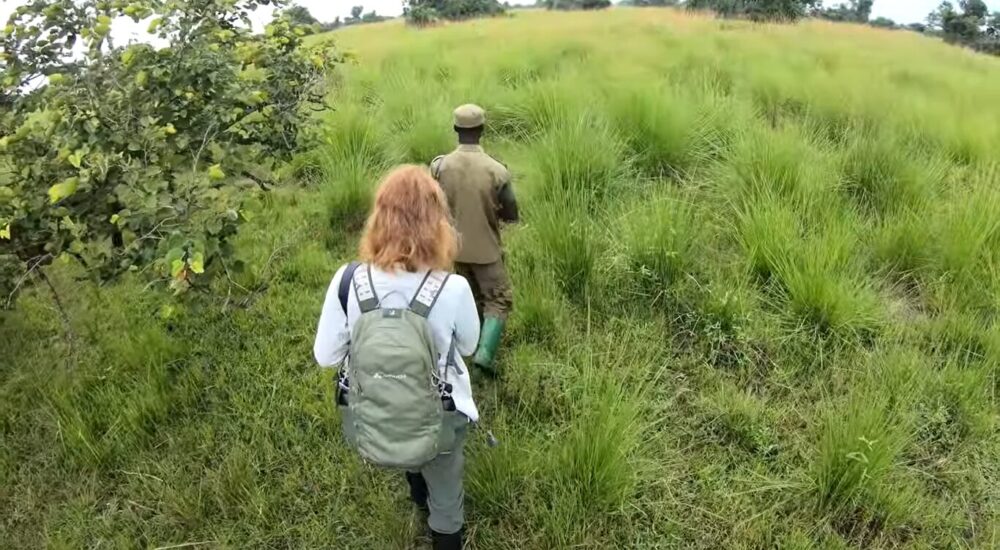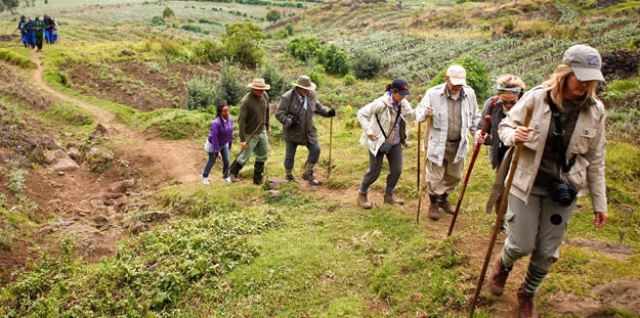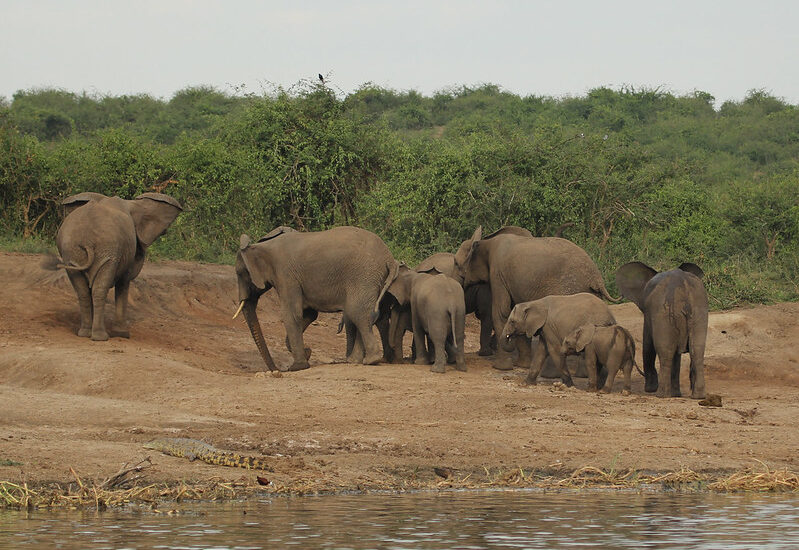Uganda, famously known as the Pearl of Africa, offers a diverse range of safari experiences,…
Mount Bisoke
Mount Bisoke Hike – A Complete Guide by Monumental Expeditions and Safaris
Mount Bisoke, located in Rwanda’s Volcanoes National Park, is a stunning volcanic peak that forms part of the Virunga Mountain range. Standing at 3,711 meters (12,175 feet), it is one of the most accessible volcanoes in the region and offers a rewarding hiking experience for adventurers and nature lovers.
This volcano is part of the Virunga Massif, a chain of eight volcanoes shared by Rwanda, Uganda, and the Democratic Republic of the Congo. Its most notable feature is the beautiful crater lake at its summit—Lake Ngezi—which lies within its caldera and is one of the key highlights of the hike. Hikers are treated to panoramic views of lush forests, rolling hills, and surrounding peaks.
Mount Bisoke is also significant for its biodiversity and conservation value. The mountain is home to various endangered species, including the critically endangered mountain gorillas. Conservation efforts in the area contribute to protecting these species and preserving their fragile habitats.
Formation of Mount Bisoke
Mount Bisoke formed due to tectonic activity along the East African Rift. The rift, which marks a divergent boundary between tectonic plates, has given rise to several volcanoes in the region. This geological activity led to the creation of Mount Bisoke, which remains a key feature of the Virunga landscape.
Last Eruption
Mount Bisoke last erupted in 1957. The eruption created the large crater lake at its summit, which remains one of the mountain’s most scenic attractions. Bisoke is classified as a stratovolcano, meaning it has steep sides formed by layers of hardened lava and volcanic ash.
Hiking Trails
Mount Bisoke offers two main hiking trails:
Bisoke Crater Lake Trail: A popular one-day hike taking 6–7 hours round-trip. It includes a 4-hour ascent to the crater lake and a 2-hour descent.
Lake Ngezi Trail: A shorter option that takes around 3 hours total—2 hours to reach the lake and 1 hour back. This trail is easier and ideal for beginners.
Another nearby option is the more challenging Mount Karisimbi Trail, a multi-day hike for experienced trekkers.
Physical Preparation
To enjoy the hike, good physical fitness is essential. Prepare by doing cardiovascular exercises like walking, jogging, or cycling. Strength training for legs and core muscles is also recommended. Practice hiking on inclines to build endurance and prepare your body for the altitude.
Gear and Equipment
Proper gear is key for a safe and enjoyable hike. Recommended items include:
Layered clothing (moisture-wicking base layer, warm mid-layer, waterproof outer layer)
Sturdy, waterproof hiking boots with ankle support
A hat, sunglasses, and sunscreen
A rain jacket (weather can change quickly)
Hiking poles for balance on steep paths
A backpack with essentials: water, snacks, a headlamp, map, compass, and first aid kit
Hiring a Local Guide
Monumental Expeditions and Safaris recommends hiring a local guide for the hike. Guides are knowledgeable about the terrain, wildlife, and local culture. They ensure your safety and enhance your overall experience. Hiring local guides also supports the local economy and promotes responsible tourism.
The Hiking Experience
The hike is moderately challenging and suitable for hikers with different skill levels. The trail to the summit takes about 6 hours, while the Lake Ngezi trail is shorter. Along the way, hikers may encounter birds, monkeys, and even buffalo or elephants. Occasionally, hikers spot mountain gorillas, but photos are only allowed with a paid gorilla trekking permit.
Expect steep and muddy paths, especially on the way down. Porters and rangers can be hired to assist with your gear and support you during the hike. Tipping them is customary and appreciated.
Flora and Fauna
Mount Bisoke’s vegetation changes with elevation. The lower slopes are covered with bamboo forests, followed by Hagenia-Hypericum forests and Senecio-Lobelia vegetation near the summit. The area supports diverse wildlife, including golden monkeys, various bird species, elephants, and buffaloes.
Cultural and Historical Significance
Near Mount Bisoke lies the grave of Dian Fossey, a renowned primatologist known locally as Nyiramacibiri. She dedicated her life to protecting mountain gorillas and combating poaching. Her legacy is deeply connected to Rwanda’s conservation story.
Mount Bisoke Hiking Permit and Fees
Hiking Permit: $75 USD per person (includes a park guide from Volcanoes National Park headquarters in Kinigi)
Porter Fee: $20 USD (optional but recommended)
Hiking Stick: Can be purchased at the park office or local shops
The hike begins at 7:00 a.m. from the Kinigi headquarters, where hikers must check in and obtain their permits.
Leave No Trace Principles
To protect the natural environment:
Stay on marked trails and avoid shortcuts
Pack out all trash and dispose of waste properly
Do not disturb wildlife
Use reusable water bottles and minimize plastic use
Keep noise levels low to preserve the serenity of the park
Safety and Emergency Tips
Check the weather forecast before hiking
Carry water, snacks, and a basic first aid kit
Wear sun protection and dress appropriately
Use hiking poles for balance on slippery or steep sections
Stay on the trail and let someone know your route
Be aware of altitude sickness symptoms and take breaks if needed
Cultural Interactions
During your hike, you may meet local community members and guides who share their knowledge and traditions. Engage respectfully, try local foods, and support local businesses by purchasing handmade crafts. These experiences enrich your journey and help support community-based tourism.
Packing Tips for Mount Bisoke
To hike Mount Bisoke comfortably, bring:
Long-sleeved shirt, sweater, and long pants
Waterproof hiking boots and trekking socks
Waterproof rain jacket
Gloves and headwear for warmth
Snacks and at least 2 liters of water
Hiking stick and a small backpack
Valid Rwanda visa or East African Tourist Visa (if combining trips to Uganda or Kenya)
Helpful Advice from Previous Hikers
Hire a Porter: They can carry your bag and help you navigate tough terrain.
Use a Hiking Stick: It helps with balance on steep or muddy sections.
Dress Smartly: Avoid being too cold or overheating by layering clothes.
Pack Energy Snacks and Water: Keep your energy up throughout the hike.
Key Facts About Mount Bisoke
Mount Bisoke is an active volcano, last erupting in 1957.
Locally, it is called Visoke, not Bisoke.
It lies within both Rwanda’s Volcanoes National Park and DR Congo’s Virunga National Park, but the summit is in Rwanda.
For guided hikes and detailed planning support, Monumental Expeditions and Safaris can help organize your Mount Bisoke trek and ensure a safe and memorable adventure in the Virunga Mountains.


